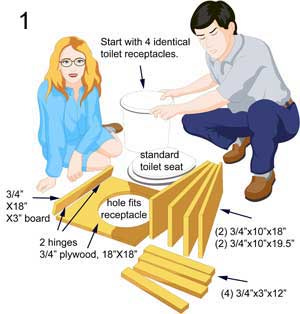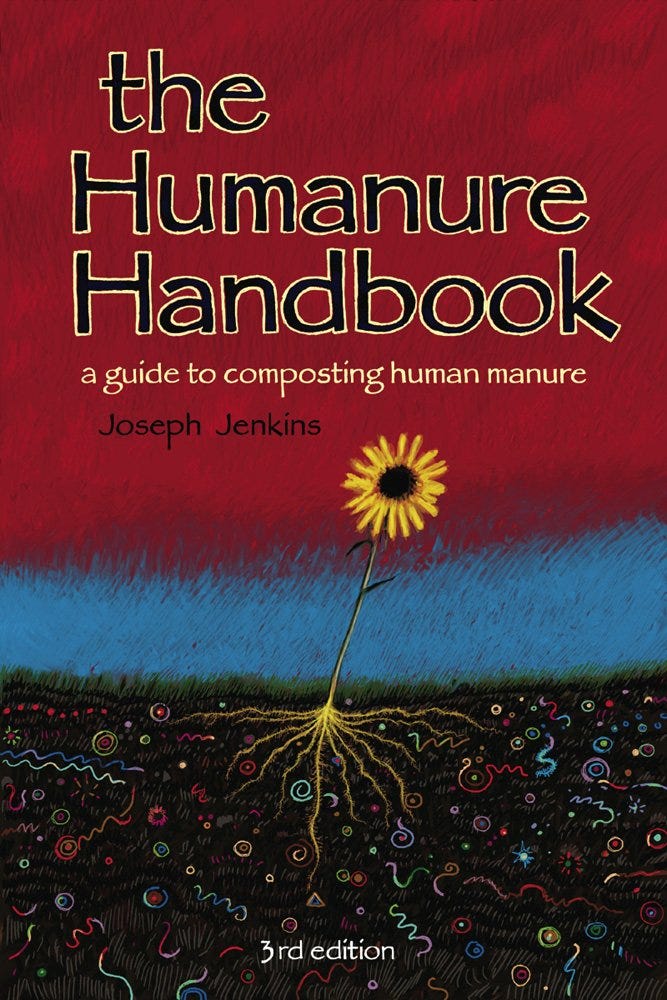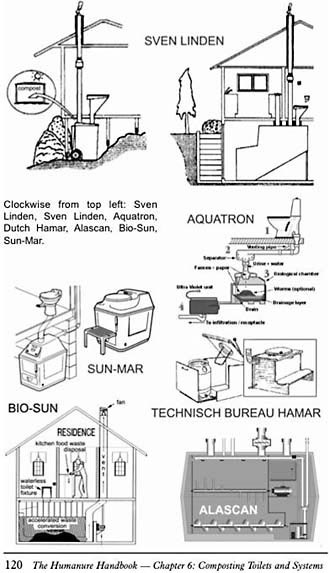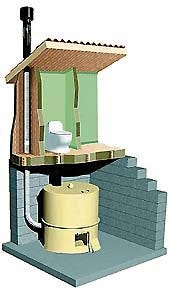Composting Toilets
Tools for Possibilities: issue no. 78
Once a week we’ll send out a page from Cool Tools: A Catalog of Possibilities. The tools might be outdated or obsolete, and the links to them may or may not work. We present these vintage recommendations as is because the possibilities they inspire are new. Sign up here to get Tools for Possibilities a week early in your inbox.

Make your own emergency toilet
Humanure Handbook Sawdust Composting Toilet
Everything you could possibly want to know about recycling human waste is found in the third edition of the Humanure Handbook.
In addition this heroic book tells you how to make your own small homemade composting toilet using 5-gallon buckets and a regular toilet seat, and how to compost the deposits usefully. This can be used for an emergency toilet, for a cabin, or in a motor home, or for everyday use if you have a garden. One of the videos on the book’s website details the clever idea of how a music festival used sawdust toilets instead of porta-potties to much relief.
The book is also available as free PDFs; the chapter on building your own sawdust toilet is Chapter 8. — KK

After using composting toilets on a few sailboats and one in a relative’s cabin, I would say they are all prone to smells, breakage and disappointment. EXCEPT for the DIY five-gallon sawdust bucket described in the Humanure Handbook. Nothing to go wrong. I’ve never had a smell issue either in the toilet or the compost pile. It requires a little bit of ongoing effort, but in my opinion this is ‘positive’ maintenance as opposed to negative maintenance when any other toilet breaks down. As an added bonus the bucket can be built into an attractive box to match the style and material of your space and looks far better than almost any toilet on the market including water closets. — Mackey McLelland
I have used this sawdust composting toilet for 10 years now without problems. There really is nothing to have a problem with. I originally envied a neighbor who had shelled out for one of the big production composting toilets. It broke in less than two years (an important mechanical part of the ‘tumbler’ was poorly designed and failed). He was left with a couple hundred pounds of incompletely composted humanure in his house. To say that he was unhappy is an understatement. He has used a sawdust toilet since then. In short, unless local regulations require a production toilet (increasingly they do not) a sawdust toilet is the way to go.
A couple of suggestions: use wood pellets if you find sawdust hard to come across; they quickly turn to sawdust. Don’t turn your humanure compost piles just leave them…for years. They will take care of themselves. You can find instructions for a sawdust toilet on line easily. It is embarrassingly simple and much more hygienic (even though most people’s first reaction, including mine, is, “Ewwww.”).
The sawdust toilet also provides a perfect emergency toilet (for hurricanes, power outages, etc) Just keep a 5 gallon bucket, 2 lids, and a bag of wood pellets in a closet. Cut a salad plate sized hole in one of the lids for use as a ‘seat’ and put the other over it to ‘close the lid’. Just make sure to dispose of the humanure responsibly after the emergency. — Rob Groesbeck

Composting crapper guide
This is the definitive source on composting crappers, from why to how, and yes, the scatological humor abounds. Yet this is a serious issue. Biosolids are recycled and used in the U.S. and around the world by governments and municipalities, and not always in the most responsible ways. Jenkins gives you the knowledge to do it yourself and do it responsibly. The entire contents of this comprehensive guide are available as a free PDF download, and the Jenkins Publishing site offers up instructional videos, too. Very helpful when I constructed my own bucket toilet. — Erik Knutzen
- “We don’t want to eat shit!” they informed me, rather distressed (that’s an exact quote), as if in preparing dinner I had simply set a steaming turd on a plate in front of them with a knife, fork and napkin. Fecophobia is alive and well and running rampant. One common misconception is that fecal material, when composted, remains fecal material. It does not. Humanure comes from the earth, and through the miraculous process of composting, is converted back into earth.
- That’s also why humanure and urine alone will not compost. They contain too much nitrogen and not enough carbon, and microorganisms, like humans, gag at the thought of eating it. Since there’s nothing worse than the thought of several billion gagging microorganisms, a carbon-based material must be added to the humanure in order to make it into an appealing dinner. Plant cellulose is a carbon-based material, and therefore plant by-products such as hay, straw, weeds or even paper products if ground to the proper consistency, will provide the needed carbon. Kitchen food scraps are generally C/N balanced, and they can be readily added to humanure compost. Sawdust (preferably not kiln-dried) is a good carbon material for balancing the nitrogen of humanure.
- A wide array of microorganisms live in a compost pile. Bacteria are especially abundant and are usually divided into several classes based upon the temperatures at which they best thrive. The low temperature bacteria are thepsychrophiles, which can grow at temperatures down to -10°C, but whose optimum temperature is 15°C (59°F) or lower. The mesophileslive at medium temperatures, 20-45°C (68-113°F), and include human pathogens. Thermophiles thrive above 45°C (113°F), and some live at, or even above, the boiling point of water.

- If a backyard composter has any doubt or concern about the existence of pathogenic organisms in his or her humanure compost, s/he can use the compost for horticultural purposes rather than for food purposes. Humanure compost can grow an amazing batch of berries, flowers, bushes, or trees. Furthermore, lingering pathogens continue to die after the compost has been applied to the soil, which is not surprising since human pathogens prefer the warm and moist environment of the human body. As the World Bank researchers put it, “even pathogens remaining in compost seem to disappear rapidly in the soil.” [Night Soil Composting, 1981] Finally, compost can be tested for pathogens by compost testing labs.
- Allow me to make a radical suggestion: humanure is not dangerous. More specifically, it is not any more dangerous than the body from which it is excreted. The danger lies in what we do with humanure, not in the material itself. To use an analogy, a glass jar is not dangerous either. However, if we smash it on the kitchen floor and walk on it with bare feet, we will be harmed. If we use a glass jar improperly and dangerously, we will suffer for it, but that’s no reason to condemn glass jars. When we discard humanure as a waste material and pollute our soil and water supplies with it, we are using it improperly, and that is where the danger lies. When we constructively recycle humanure by composting, it enriches our soil, and, like a glass jar, actually makes life easier for us.

Commercial options
I grew up with a Carousel composting toilet in our house. It works well, Draining the urine, using a scoop of sawdust every time, and the occasional insertion of beneficial bacteria, all help prevent odors. We had a 12V fan, as well. Two years is the recommended time for between deposition and cleaning. We used it as our primary family toilet for over 15 years, before my father no longer wanted to clean it. It never broke down, and never had any issues. It can handle a whole family year round.
For individuals or occasional vacation use, I’d recommend the Sun-Mar standard Excel. — Courtney Ostaff







